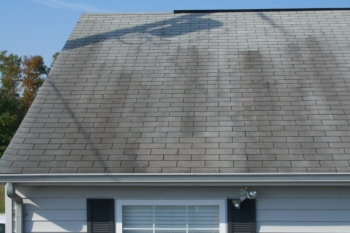
Actually, the best way to fight the staining and discoloration from algae is to prevent it from growing. Manufacturers offer products with algae-inhibiting features. Labeled “algae resistant” (AR) or “fungi resistant” shingles, they have zinc granules mixed in with the normal ceramic granules on the surface of the shingles to help prevent algae growth. Copper or zinc strips placed at the ridge area of the roof can also control the growths. Installing a dark roof will not prevent the algae problem but it will be less apparent.
Surface residues or discoloring stains can affect almost any type of roof. One particular condition that has been an issue in southern areas for many years, but has become more commonplace in other regions in recent years, is the staining of asphalt shingle roofing caused by algae. Generally, this condition only affects a roof’s appearance; although, when present on certain roof products or when there are other detrimental conditions present, it may impact the overall service life of the roof.
The staining and discoloration caused by algae initially appear as dark brown and black, or sometimes greenish streaks on the roof surface. It’s most noticeable on white or other light-colored roofs. This discoloration is different from the stains caused by dirt and tree debris that tend to accumulate on localized areas of a roof, but it is not uncommon to find both conditions on the same roof.
Because of its appearance, the discoloration from algae is sometimes referred to as “black mold” staining. But the majority of the growths are not mold fungi at all, but a type of algae formation that feeds on organic material such as the filler (calcium carbonate) used in the ceramic granules installed on the surface of the asphalt shingles.
The algae growth tends to occur most often on shingles with northern and eastern exposures or where the roof is shaded and slow-to-dry after precipitation. The growths can be found in almost all regions, although the problem is more widespread where the weather is warm and damp a good part of the year. But just even short periods of wet summer weather can allow the algae to get established and begin spreading. Cold, dry weather will slow or stop the spread, but may not eliminate the condition altogether, as the stains will remain, and the algae will continue to spread when conditions are favorable again.
Algae spores are carried by the wind. Once the spores alight on a roof, if conditions are favorable for growth, the algae will continue to spread, typically moving up and across the entire roof – and release more spores that move from one roof to the next throughout a neighborhood. The subsequent growth of moss and other fungi that thrive on the algae and other organic matter that accumulates on the roof can exacerbate conditions.
Commercially available treatment products can be used to arrest the growth, and in some cases clear the staining. There are also professional roof cleaning services that specialize in removing the stains or abating the spread. Only cleaning solutions recommended by the roof manufacturer should be used.
Some methods used to remove or fight the algae are potentially damaging to the roofing and to the surrounding property. Aggressive washing (e.g., by scrubbing, or high-pressure spraying) and the associated foot traffic on the roof can cause loss of granules or other damage to the shingles – leading to premature shingle failure.
To avoid injury or roofing damage, it is best to have roofs treated professionally. The cleaning solutions will make the roof surface slippery and hazardous. Before applying cleaning solutions, any heavy dirt buildup or debris should be carefully removed. Foundation plantings should be covered and the applicator should wear protective glasses, gloves, and clothes. Some cleaning solutions can kill grass and other vegetation, so run-off from the treatment process should be collected or diverted to a suitable drainage point. It’s also important to rinse the gutters and other surfaces with clear water to prevent the solution from corroding or staining them.
While some treatments will kill the algae immediately, it may take several days or weeks for the color to fade. Unfortunately, cleaning is, at best, only a short-term benefit in most cases. If spores are present or return, the algae will begin to grow again as long as favorable climatic or weather conditions are present.
Note: These tips are only general guidelines. Since each situation is different, contact a professional if you have questions about a specific issue.
